2017 Infiniti Q60 Review: First Drive


CARS.COM — Since I first saw the 2017 Infiniti Q60 at the North American International Auto Show in January, I’ve been excited to drive it. Our staff unanimously called it a winner from that show, and I said that “if it drives like it looks, Infiniti has a definite winner.” So I headed to north San Diego County to see how the Q60 stacks up.
Related: 2017 Infiniti Q60: First Look
Looking back at the company’s history, the best cars that Infiniti has produced were sporty coupes: the G35, followed by the G37 that was renamed and sold as the Q60 — essentially unchanged — until 2015. Infiniti is hoping that the redesigned Q60 can follow in that tradition, and I’m happy to report that it does, with a resounding bang.
The Q60 is offered in four trim levels: base, Premium, Silver Sport and Red Sport. I drove both rear- and all-wheel-drive versions of the Red Sport, the most lavishly equipped and fastest, most performance-oriented of the bunch.
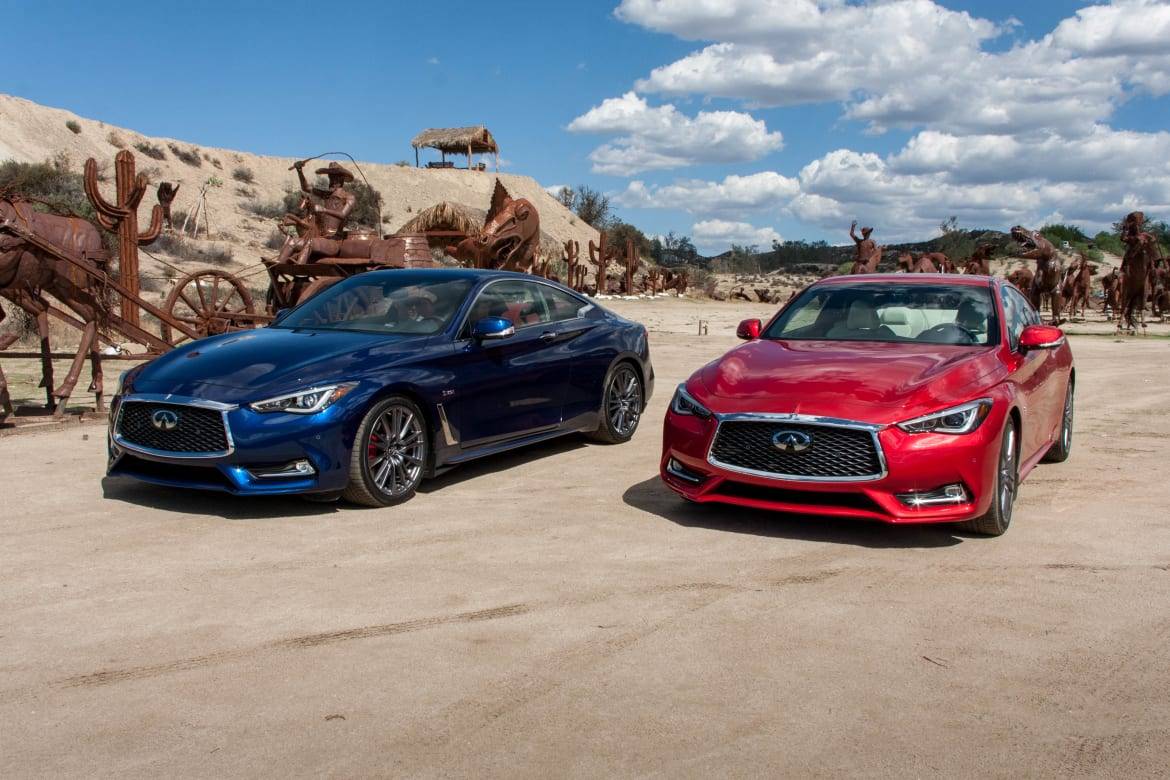
Under the hood of the Red Sport is a brand-new engine for Infiniti, a twin-turbocharged 3.0-liter V-6 that comes in two forms: In 3.0t Premium and Silver Sport trims, the engine makes 300 horsepower and 295 pounds-feet of torque, but in the Red Sport, those figures jump up to 400 hp and 350 pounds-feet of torque. The extra power comes thanks to the addition of an optical turbine speed sensor that allows the turbos to spin faster, which increases the amount of boost pressure and, hence, more power. Both versions employ a water-cooled intercooler system for more efficient operation than could be achieved with the type of air cooling used in the base 208-hp, single-turbocharged 2.0-liter four-cylinder. (I drove only the V-6.) The 400-hp V-6 also adds a second water pump to increase flow and compensate for the greater heat that comes with higher boost pressures.
Those worried about lag from the twin turbos will be happy to know that the engine has a flat torque curve and produces peak torque from 1,600-5,200 rpm. That makes the power delivery from the engine smooth and predictable, even at low engine speeds, and there isn’t the sudden burst of power you get from some other high-powered turbo mills. For more details on the engine, Infiniti fills in the details here.

The engine is mated to a seven-speed automatic transmission with steering-wheel-mounted paddle shifters. Infiniti also told us that it will offer RWD or AWD across the whole Q60 lineup, not just Red Sport versions, which is good news for car shoppers who live in colder climes.
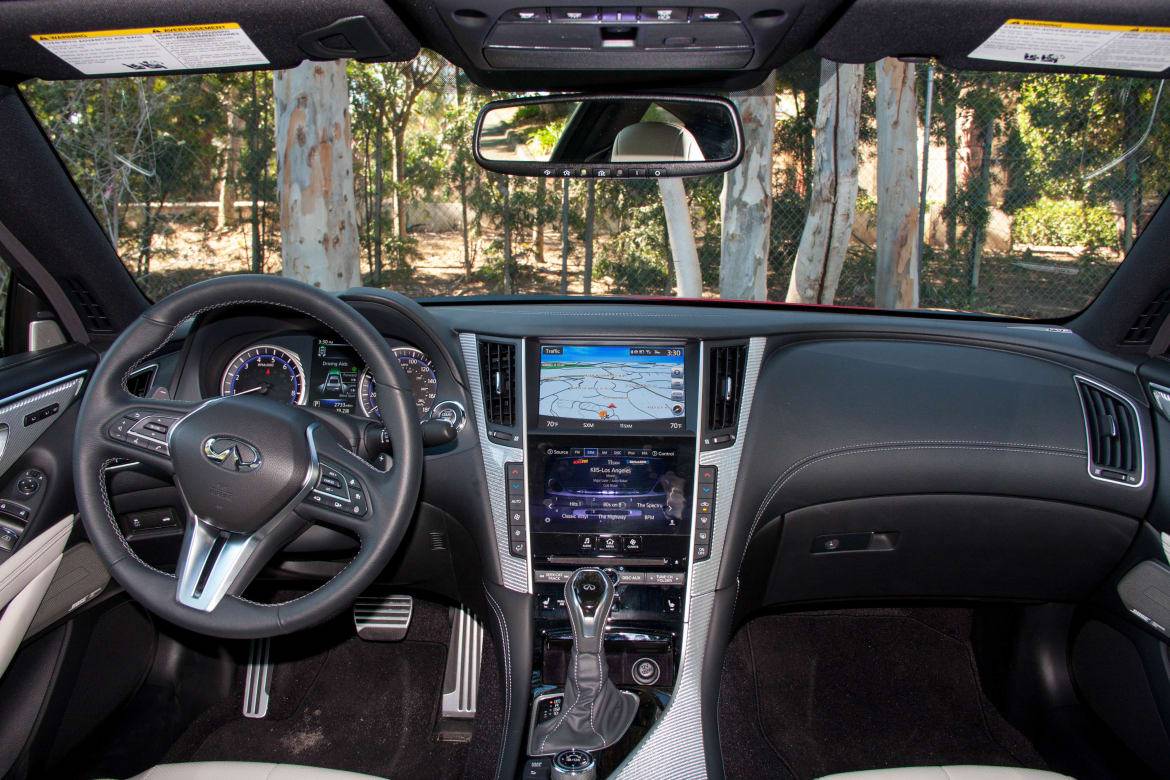
The Q60 doesn’t skimp on performance technology and, with it, the potential that so many systems with words like adaptive and dynamic in the names will result in a disconnected driving experience. And the Red Sport is overrun with them: Direct Adaptive Steering, Dynamic Digital Suspension, Active Trace Control and Adaptive Shift Control. That’s a lot of technology to pack into a drivetrain and suspension.
This may make me sound curmudgeonly (“Them newfangled do-hickeys are ruining good old-fashioned motoring”), but there is a nugget — a big nugget — of truth to that sentiment. We want to drive cars that feel like cars. And Infiniti was up front about the Q60 being a vehicle that puts more of an emphasis on fun and driving than qualities like practicality and cargo room — it’s a luxury coupe, after all. You don’t buy a two-door because it’s good for the family; it needs to be quick, stylish and fun to drive. The Q60 Red Sport definitely checks the first two boxes, but the third was a big question mark for me.
My doubts didn’t last long. I was not expecting this, but all of that driver-centric technology upped the fun instead of taking away from it. Our drive was on public roads, so I didn’t have a chance to drive the car at full bore, but on our curvy, meandering drive route around the hills of northern San Diego County, the Q60 handled everything I threw at it with what I imagined to be a big, goofy grin to match the one plastered across my own face. It’s a car that likes to be pushed, that invites challenges to the amount of grip and acceleration it can provide — both of which are there in spades.
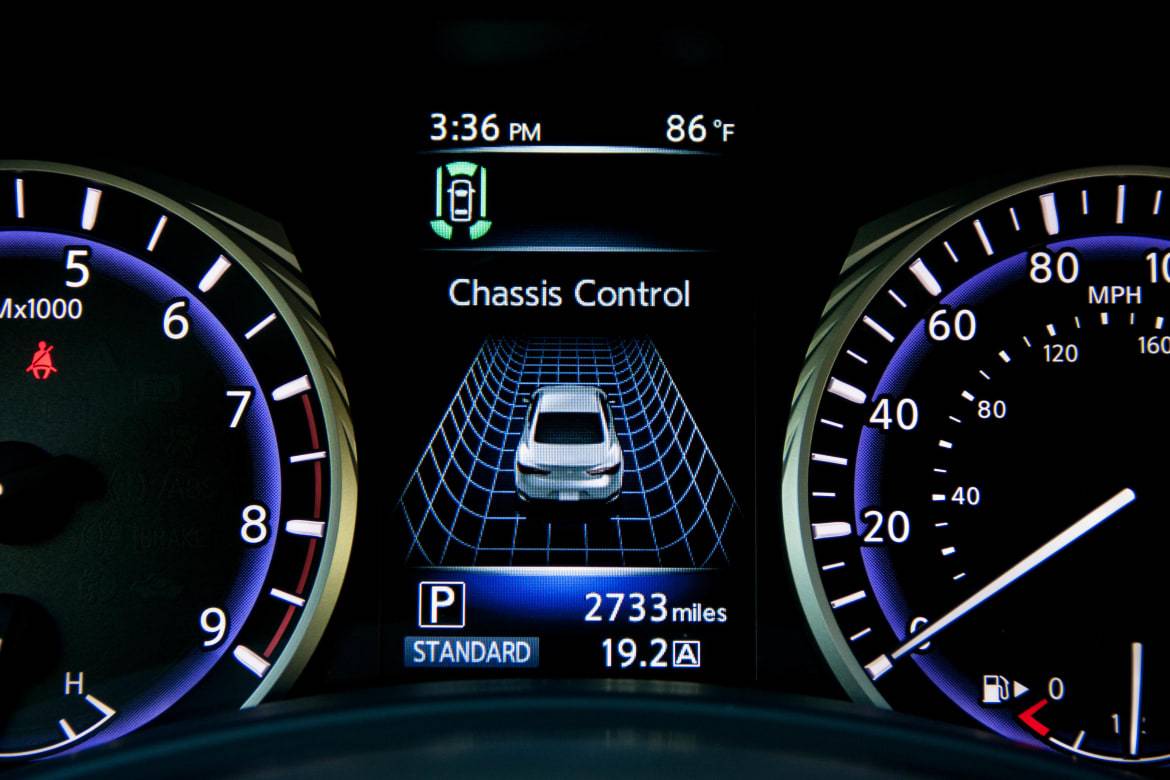
For a steering system with no mechanical linkage to the wheels (except a backup system that remains passive), the feel is impressive. The system debuted in the Q50 Red Sport last year, but Infiniti says it updated the software to provide more feedback to the driver. The steering was accurate and I was able to place the car where I wanted easily coming into and out of turns.
I was also concerned that the adaptive suspension would numb the experience. Similar to competing vehicles, it uses electronically adjustable shock absorbers at all four corners to help keep the Q60 flat under cornering, which in turn increases the amount of traction you have since the car doesn’t start to lean over the outside wheels. Other systems I’ve driven work almost too well, keeping the car flat but muting feedback. The suspension in the Q60, however, was also bang-on. Even though the car stayed flat, I could still feel the limits of the grip and acceleration forces weren’t muted, so I still got the sensation of speed. To say I had a good day on the road would be a massive understatement.
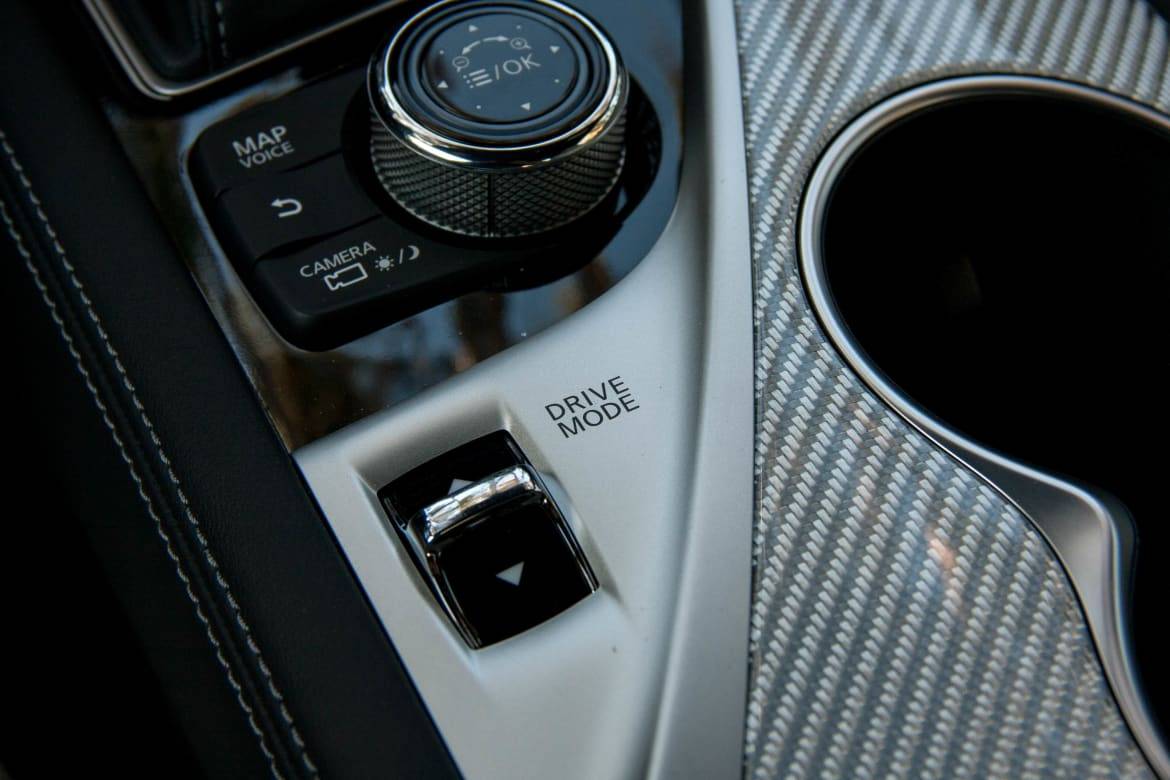
All of these electronically controlled systems — the engine, steering, suspension, etc. — have independently adjustable settings. Infiniti engineers said there are actually 336 ways you can set up the car. I stuck with the five pre-loaded drive modes: Snow, Eco, Standard, Sport and Sport Plus. Each gets progressively sharper as you move up. Sport Plus offers the most aggressive throttle response, the firmest suspension and the quickest steering ratio. There were portions of the day where I used each mode, which I can’t say about most cars I test. There is one exception to the Q60’s fun — Eco mode. I would suggest leaving it alone, especially in the city. It cuts accelerator response too aggressively, making starts from a standstill in Eco mode feel like a chore because the variable-resistance pedal becomes harder to press. Once you’re at speed (on the highway, for example), Eco is fine for maintaining speed, but driving it on surface streets was unpleasant.
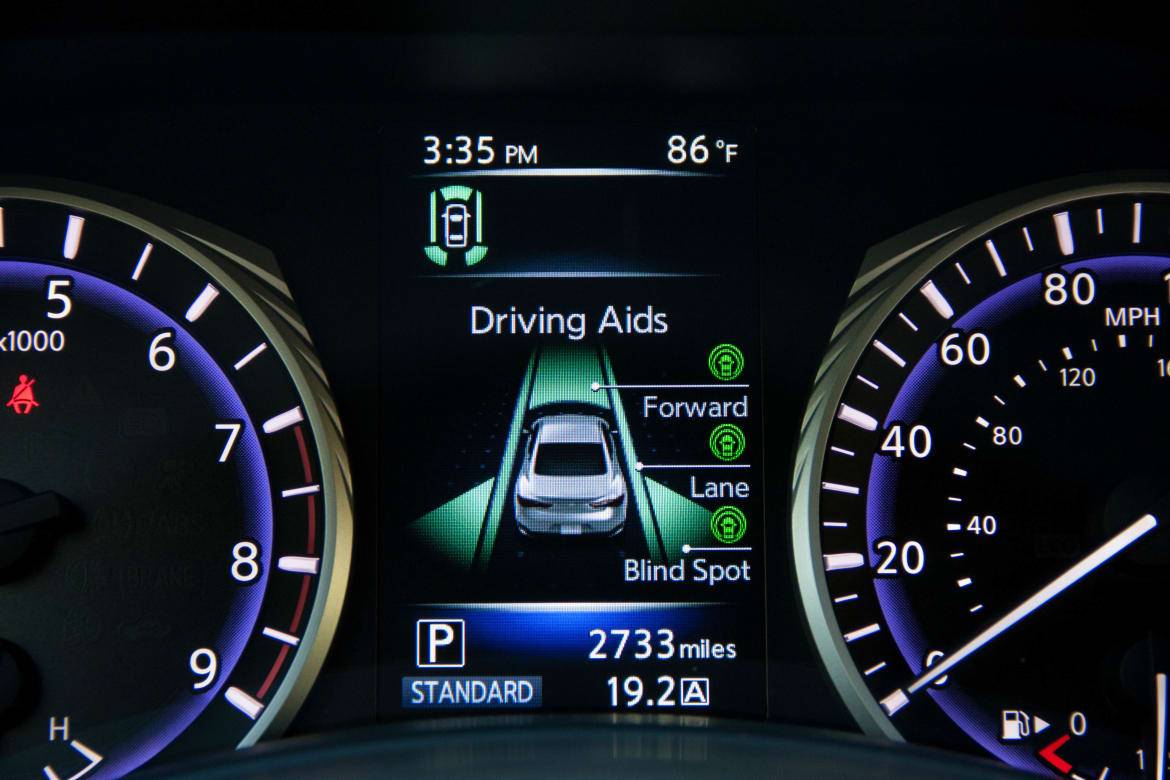
Infiniti also upgraded the Q60’s safety technology in the redesign, with available 360-degree cameras, adaptive cruise control, forward collision warning with pedestrian detection and automatic emergency braking, lane departure warning and prevention, blind spot warning and backup collision intervention that can stop the vehicle if it detects an object behind the car.
A small button on the steering wheel activates three of these systems: lane departure warning and assist, a more robust forward collision warning with automatic braking, and blind spot monitoring with what Infiniti calls Blind Spot Intervention. If the system detects you changing lanes with another vehicle already there, it will use the Q60’s brakes to bring the car back into the lane safely. The lane-keeping system also has enhancement beyond correctively pulling the car back into the lane if it detects drift — it has active lane centering that will actually help you steer the car with just a nudge of the steering wheel in either direction. It’s a bit eerie.

I also made another interesting discovery. With those three systems on and the adaptive cruise control running, the Q60 can practically drive itself, similar to semi-autonomous systems from Mercedes-Benz, Tesla and Volvo. Our drive route included 15-20 miles on the highway, where I flipped on all of the driving aids along with the adaptive cruise control, then let the car do the work. Until the freeway began to curve more sharply toward the end of the trip, the Q60 essentially drove itself for a 10-minute stretch without any input from me, and with no signal for me to take the wheel, as similar systems have. I would recommend continuing to pay close attention (I held my hands about an inch from the wheel the whole time, waiting to take over), but as a testament to the technology, it was impressive.
The 2017 Q60 Red Sport exceeded my expectations. It was composed, it was quick and it was oh-so-pretty in that eye-catching red paint. That was a day I’ll remember for quite a while.
Click here to see pricing for the full Q60 lineup.

Former L.A. Bureau Chief Brian Wong is a California native with a soft spot for convertibles and free parking.
Featured stories




